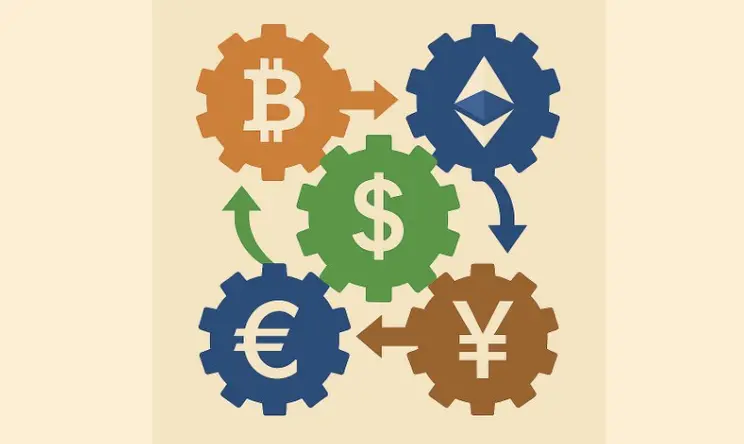Ethereum faces a wave of liquidations, the Solana ecosystem's meme trend weakens, when will the turning point in the crypto market arrive?
Original Title: "Solana Breaks Record, Ethereum in Crisis -- When Will the Turnaround Come?"
Source: BlockBlick
Compiled by: Yuliya, PANews
After months of intense fluctuations in the crypto market, the latest episode of the "BlockBlick" podcast provides a detailed analysis of recent dynamics in the crypto market, particularly the performance of Ethereum and Solana, as well as the future direction of the entire cryptocurrency market. PANews has provided a written compilation of this episode.
Ethereum: Price Slump and Ecological Progress
Recently, the Ethereum market has experienced significant volatility, setting a historical high for daily liquidation volume. According to Coinglass data, the liquidation volume for Ethereum's long and short positions in a single day exceeded that of previous major events, including the FTX collapse and the Three Arrows Capital crisis. Market sentiment is extremely low, with short positions in Ethereum on the CME futures market also reaching new highs, indicating a lack of confidence among investors. Nevertheless, some investors are taking advantage of the price pullback to position themselves, with over $300 million flowing into Ethereum-related ETFs this week.
Ecological Technological Progress
Despite the weak price, Ethereum's technical ecosystem is steadily developing:
- Transaction Throughput Hits New Highs: The transaction processing capacity of the mainnet and Layer 2 networks has reached historical highs, indicating an enhancement in the network's scalability.
- Gas Limit Increase: The gas limit on the Ethereum mainnet has been raised by over 20%, resulting in an increase in transactions per second (TPS) while significantly reducing transaction fees. In the past week, Ethereum's mainnet transaction fees have dropped to historical lows. Layer 2 solutions like Base have raised gas limits to 60 million in hopes of increasing network throughput and further expanding market demand.
- Growth of Tokenized Assets: The total value of tokenized assets on the Ethereum mainnet has exceeded $17 billion, dominating the market. Physical assets, including loans, commodities, and U.S. Treasury bonds, are being transferred to the blockchain in large quantities, with over 80% of tokenized assets distributed across the Ethereum mainnet and its Layer 2 networks.
Inflation Issues
However, low gas fees also reflect a decline in Ethereum network usage, with a slowdown in ecosystem activity. Since the merge, Ethereum has entered an inflationary state for the first time, with the current supply of Ethereum exceeding pre-merge levels, indicating an increase in the number of Ethereum tokens circulating in the market. Observing the Ultrasound Money chart, it can be seen that Ethereum's deflationary trend had persisted for years, but since the emergence of Layer 2 scaling solutions, which reduced reliance on the main chain, the amount of Ethereum being burned has decreased, leading to a gradual return of Ethereum's supply to an inflationary state.
However, compared to Bitcoin, Ethereum's inflation rate remains relatively low, expected to fluctuate between -1% and +1% in the future. Therefore, although the market expresses concerns, this fluctuation is anticipated and does not imply a threat to the long-term health of the Ethereum ecosystem.
It is worth noting that only 1% of Bitcoin miners' income in the past week came from transaction fees, with the remainder primarily relying on block rewards. Given Bitcoin's halving mechanism every four years, if mainnet transaction volumes do not significantly increase, miners' income may face challenges in the future.
Solana: Technical Stability and Meme Coin Craze
Improvement in Technical Stability
In contrast to Ethereum's challenges, Solana is showing strong momentum. Although its price has fallen from a historical high of $250 to $202, the decline is relatively moderate. The Solana network recently achieved an important milestone: it has operated for a full year without major outages, which is significant in its development history. Particularly in the past 35 days, even amid peaks such as the Meme coin craze and the launch of Trump meme coins, the network has remained stable.
According to Artemis data, Solana is far ahead in terms of daily active addresses:
- Solana: 5-6 million active wallets daily
- Base: about 700,000 to 800,000
- Ethereum mainnet: about 400,000
These developments may impact the competitive landscape of the cryptocurrency market. While Ethereum maintains a lead in enterprise-level applications and tokenization of physical assets, Solana's advantages in performance and user activity cannot be overlooked. This competitive dynamic offers market participants a more diversified range of investment options.
The Double-Edged Effect of the Meme Coin Craze
The recent activity in the Solana ecosystem has partly benefited from the popularity of Memecoins, particularly driven by the Pump.fun platform. Data shows that this platform generates about 70,000 new tokens daily, with a total reaching 7.5 million. According to CoinMarketCap, the total number of tokens issued is close to 11.04 million, indicating a significant market share for Pump.fun.
However, the Meme coin craze has also brought some negative effects: a large influx of funds into the Memecoin market has led to reduced attention on other projects, dispersing market funds. Additionally, many investors have incurred losses due to the high speculation of Memecoins, further weakening market confidence. This presents a significant challenge for the current cryptocurrency market: despite a large influx of funds, most are directed towards short-term, high-risk investments, lacking projects with long-term sustainable development. In this process, while some projects like Bitcoin and Solana have shown stable growth, others struggle to generate meaningful value. This situation places the entire market in a precarious state, especially for Ethereum, which remains a leader among projects with long-term value.
Despite Solana's progress in technical stability, on-chain activity has recently declined. Data shows that the number of active addresses on Solana and the trading volume of Memecoins have both retreated from their peaks, indicating a waning enthusiasm for Memecoins in the market. The launch of Trump Meme coins is considered the peak of this craze, but as speculative fervor diminishes, Solana needs to seek new growth drivers. Additionally, the activity of Base and other blockchains has shown similar declines, indicating a reduction in retail participation across the entire crypto market.
Meanwhile, Bitcoin's network activity has also shown similar weakness, with overall blockchain activity experiencing a downturn. A significant issue in the current market is that many investors seem to have lost their enthusiasm for cryptocurrencies, especially in the absence of sufficient "cheap capital," lacking large-scale market incentives. Due to macroeconomic factors such as interest rate hikes, demand for risk assets has decreased, leading to underperformance in the crypto market.
High Interest Rates, Inflation, and Money Supply
Historically, periodic bubbles and downturns are common phenomena in the cryptocurrency market. During periods of low market sentiment, it is often the time when new entry opportunities arise. Currently, we are in a relatively negative market sentiment phase, with declining market activity; however, this may precisely signal a potential rebound in the future. As the Crypto Fear and Greed Index illustrates, when the market is in a state of fear, it is often a time when opportunities may arise in the long run. At this point, investors may begin to reposition themselves, and market sentiment could shift towards the positive.
The main issue in the current market lies in the interest rate environment. A true altcoin bull market, the so-called "altcoin season," can only occur when people can access low-cost capital. However, in this cycle, due to U.S. interest rates remaining high at around 4.5%, the market has not seen this situation.
In terms of market liquidity, from last November to January 20 during Trump's presidency, billions of dollars in stablecoins flowed daily into cryptocurrency exchanges like Binance and Coinbase. However, this strong momentum has weakened, and while positive inflows are still maintained, the momentum has clearly declined and may even turn negative.
Regarding future trends, the market is primarily focused on the Federal Reserve's policy direction. Currently, U.S. inflation remains relatively high, and the Federal Reserve is not yet prepared to cut interest rates, which somewhat limits market development and delays the arrival of a true altcoin season.
The next Federal Reserve interest rate decision will take place on March 18-19. Trump is actively pushing for interest rate cuts, which is one of his key policy agendas. Only when market funds are abundant can businesses thrive and venture capital become active. Trump has strongly criticized the decision to maintain interest rates on January 29, but rate cuts still face challenges until inflation issues are fully resolved.
From the data, U.S. inflation rates are nearing the target level of 2%. Since June 2022, inflation rates have been on a downward trend, although there have been some stalls during this period, the overall downward trend continues. The market expects a 92% probability of the Federal Reserve cutting rates in March, which is a strong expectation. However, some believe that Trump's tariff policies may lead to a rebound in inflation, although this impact may be limited to specific goods and will take time to reflect in the data.
The decline in oil prices is crucial for controlling inflation, and Trump is vigorously promoting increased domestic oil production. Additionally, the weakness of the dollar also provides favorable support for Bitcoin prices. Therefore, from the data perspective, this stage may be a good entry point.
Although the fundamentals are improving, the market currently faces many uncertainties, including the specifics of tariff policies and potential responses from China and the EU. These uncertainties put pressure on the market, but this situation will not last forever.
Institutional and Regulatory Progress
Many significant changes are occurring in the market. While not all issues have been resolved, some progress is still noteworthy:
- Cryptocurrency Task Force: Under the leadership of HESTP, a dedicated cryptocurrency task force has been established. They will work to quickly establish a regulatory framework to clarify the rules for all investors operating in the cryptocurrency and blockchain markets. The task force will continuously publish updates through its official website.
- Bitcoin ETF Plans: Trump's media group (Trump Media Group) plans to launch a Bitcoin ETF called "Truth Bitcoin Plus ETF," indicating that the Trump media group is also entering the ETF space, attempting to expand its influence in the cryptocurrency market through the launch of a Bitcoin ETF.
- Klarna Enters Crypto Payments: The well-known European payment company Klarna is expanding its cryptocurrency business. They plan to integrate cryptocurrency payment functionality into their existing application, meaning users will be able to use cryptocurrencies directly for payments through the Klarna platform in the future.
- Rumors in the Chinese Market: There are again rumors about China possibly re-accepting cryptocurrencies. While such news tends to emerge every few years and its authenticity remains to be verified, it is still worth paying attention to.
Overall, the cryptocurrency industry is undergoing unprecedented fundamental changes:
- The U.S. is establishing a positive regulatory framework, demonstrating a willingness to lead in the cryptocurrency space, similar to the early internet era's support for companies like Facebook and Amazon.
- Today, other countries around the world also recognize that the cryptocurrency market is becoming an important part of the future economy and express a desire to participate.
- Although these changes will take time and may not meet the market's expectations for rapid change, the direction of development is clear.
The current market cycle is indeed longer than previous ones, and there are ample reasons for this:
- High interest rate environment persists
- Inflationary pressures remain
- Completely different from the environment of massive monetary easing during the COVID-19 pandemic
- Currently in a more stable economic environment, with no urgent pressure for the Federal Reserve to cut rates
From a positive perspective, the economy's ability to withstand the current high interest rate levels is itself a healthy sign. This indicates that the economic fundamentals remain robust, laying the foundation for future sustainable development.
Summary and Recommendations
The current market environment is vastly different from the past. If policies are overly loose, it may trigger a new wave of inflation in the long run, which is clearly not the outcome the market desires.
For market participants, it is crucial to remain calm and rational. Currently, it is necessary to:
- Temporarily avoid using leverage
- Be patient and accept the fact that the market may take longer to show signs of a turnaround
- Continue to pay attention to the market and not completely disengage
- Learn from the mistakes of investors who were forcibly liquidated last Monday
Maintaining a cautious and calm investment mindset is more important than ever. Market dynamics will continue to update, and it is essential to remain vigilant and strictly control risks.










